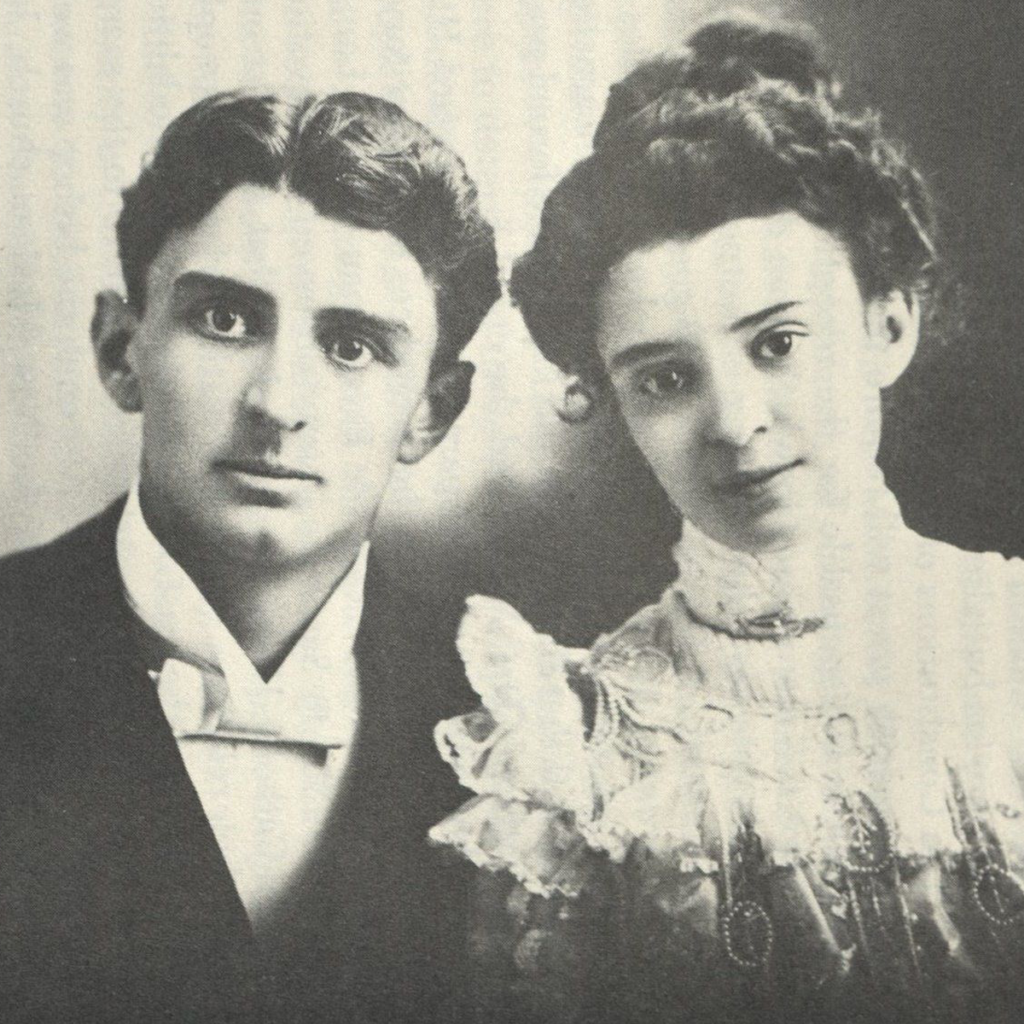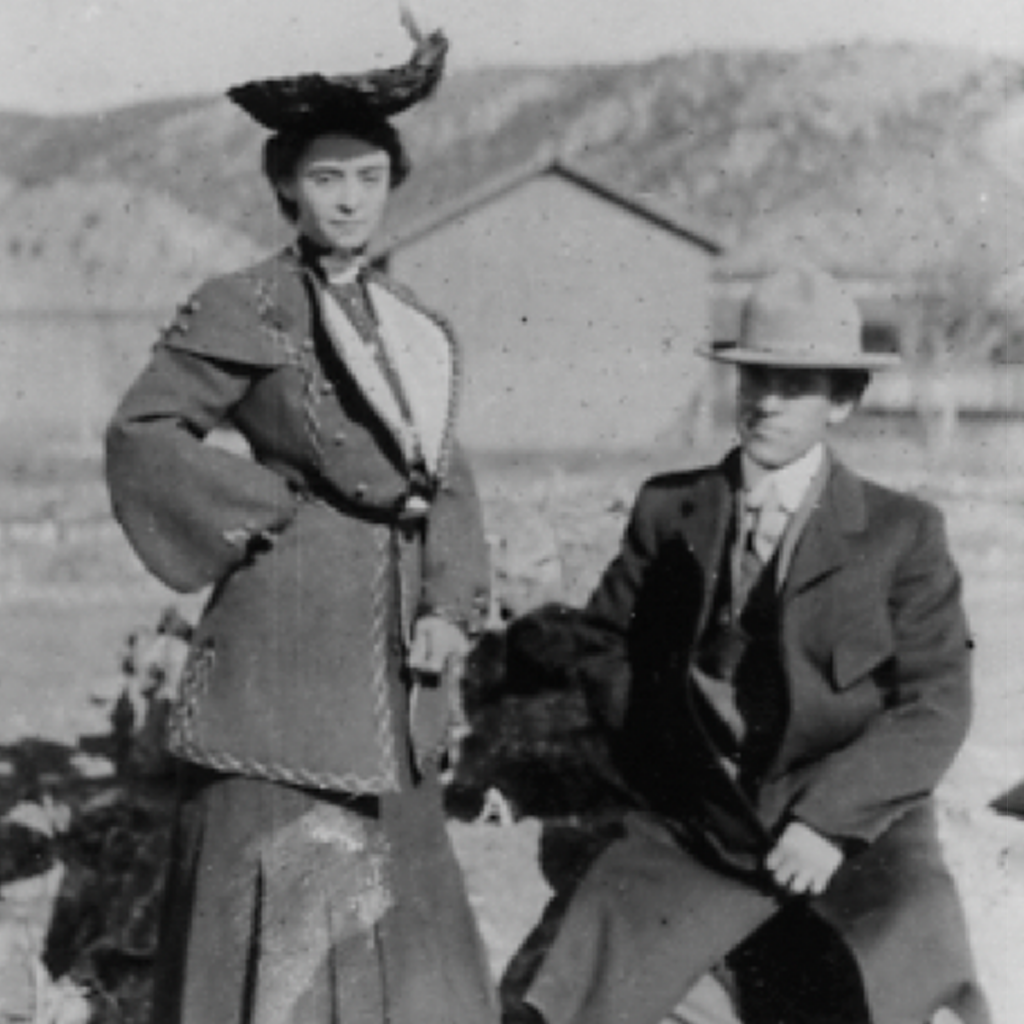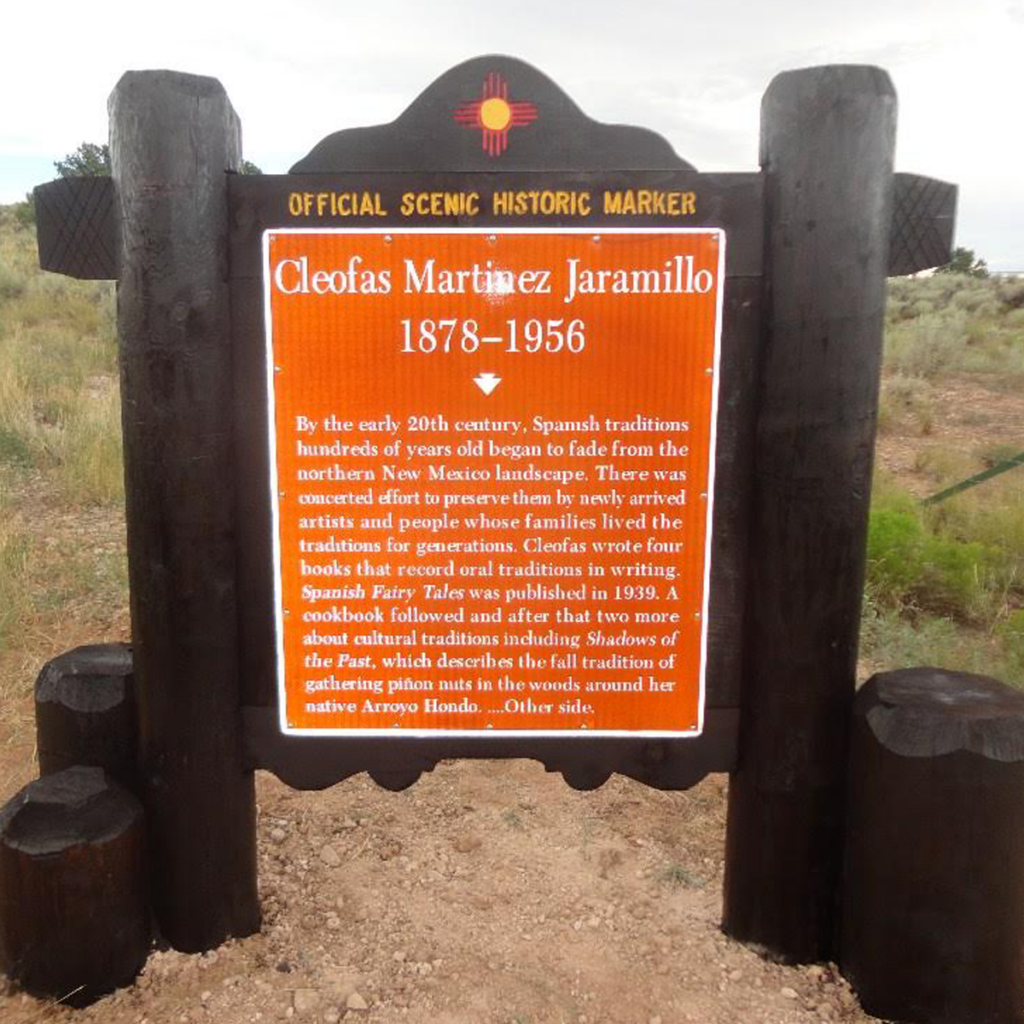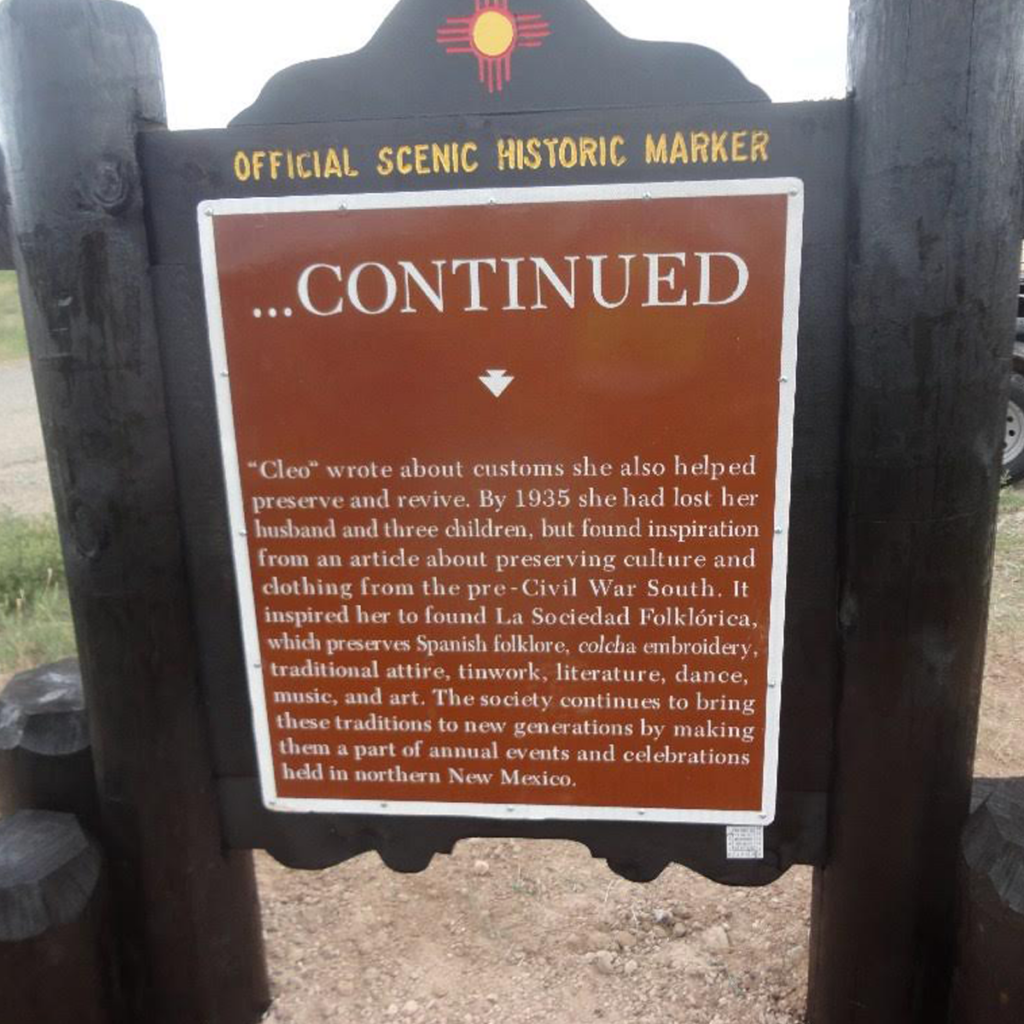Cleofas Martinez Jaramillo.
Cleofas Martinez Jaramillo
1878 - 1956
Taos County
As Spanish traditions began to fade in New Mexico, she wrote books to record important oral traditions in writing and founded La Sociedad Folklόrica, which today continues to preserve Spanish folklore, colcha embroidery, traditional attire, tinwork, literature, dance, music, and art.
By the early 20th century, Spanish traditions hundreds of years old began to fade in northern New Mexico. Newly arrived artists and people whose families had lived the traditions for generations made concerted efforts to preserve traditions. Cleofas Martinez Jaramillo was an important part of this effort to preserve Spanish traditions. She wrote books that provide written records of oral traditions, including Spanish Fairy Tales published in 1939, a cookbook, and two more books about cultural traditions including Shadows of the Past, which describes the fall tradition of gathering piñon nuts in the woods around her native Arroyo Hondo.
Known as “Cleo,” she not only wrote about customs, she actively helped preserve and revive them. By 1935 she had lost her husband and three children, but found inspiration from an article about preserving culture and clothing from the pre-Civil War South. It inspired her to found La Sociedad Folklόrica, which preserves Spanish folklore, colcha embroidery, traditional attire, tinwork, literature, dance, music, and art. The society continues to bring these traditions to new generations today by making them a part of annual events and celebrations held in northern New Mexico.
Cleofas Martinez Jaramillo was born on December 6, 1878 in Arroyo Hondo to Julian Antonio Martinez and Marina Lucero de Martinez, descended from the first families to have settled that village—her grandfather owned a portion of the Arroyo Hondo land grant. She had six siblings, a sister and five brothers; her father owned a successful store in Arroyo Hondo and raised sheep. By all accounts, she lived a privileged childhood, steeped in relative wealth and Hispanic culture.
She described her parents this way: “Both were equally energetic. They had time for everything—work, hospitality, religion, and even politics. While my father lived at Arroyo Hondo, his political party never lost their election in that precinct. He ran his combined dry goods and grocery store without help. He directed the work on his farms, and his lands produced all kinds of grain, vegetables, and fruit. He raised beef, sheep, pork and race horses. These were his chief industries, but there was no limit to his ambitions. He branched out into many others. He read his Bible and kept in it a record of the births and deaths of members of his family.”
Cleofas attended the Loretto Convent School in Taos at age nine and later Loretto Academy in Santa Fe. In 1898, she married Colonel Venceslao Jaramillo, her cousin, in Taos. The couple lived in El Rito, where Colonel Jaramillo ran a sheep business and also represented San Miguel County in the state legislature, becoming an influential politician and, at one time, chair of the Republican Party.
Throughout her life, she suffered many tragic losses. Her first two children, a boy and a girl, died young. Later, in 1920, her husband passed away from illness, leaving Jaramillo to raise their third child, Angelina—only four years old—and also manage the affairs of his estate and business while getting out of debt. During his illness, the couple had moved to Denver; after his death, she returned to New Mexico and lived in Santa Fe.
In 1931, in another tragic incident, her daughter Angelina was murdered in their home. Jaramillo later wrote of the incident, “Destiny, still not satisfied, seemed bent on crushing me down to the very last of my endurance.”
In 1935, a widow and alone, she read an article in Holland’s Magazine–a women’s magazine on gardening, sewing, and recipes–about the Natchez Pilgrimage in Mississippi. Celebrated each year in Natchez, Mississippi, the event celebrates traditions and includes displays of historic antebellum gowns and fashion. Seeing parallels to the Santa Fe Fiesta, she organized a group of like-minded individuals to wear historic gowns and shawls at the Fiesta. As she described in a talk in 1950, “…it occurred to me that if we would look in our mothers’ trunks we would find old costumes and jewelry which could be displayed at our Fiesta. I thought we who know the customs and styles of our region are letting them die out.” The first participants of this display felt the event was a success, and she and a group of ten other women chose to make the group permanent. This was the beginning of La Sociedad Folklórica in Santa Fe.
In 1955, Jaramillo wrote of the organization: “La Folklórica is still the name of it today, and first rules which I drafted still govern the organization. These rules were that the society should be composed of only thirty members, all of whom must be of Spanish descent, and that the meetings must be conducted in the Spanish language, with the aim of preserving our language, customs and traditions.” The non-profit La Sociedad Folklórica today states its mission as: “To collect, preserve and pass on the knowledge of the customs and traditions of our Spanish ancestors, (some centuries old), to younger generations and to the general public.” It annually hosts the “Exhibicion de Modas y Merienda,” a display of “treasured heirlooms and gowns of yesteryear” held in association with the Santa Fe Fiesta.
Jaramillo also turned to writing to capture the traditions and stories she felt were fast slipping away. This capturing of tradition through writing took place at a time when Taos, Las Vegas, and Santa Fe were undergoing a cultural renaissance as Anglo and European writers, artists, and craftspeople moved to the area. Along with other Hispana writers of the period, including Aurora Lucero White, Nina Otero Warren, and Fabiola Cabeza de Baca, she was concerned that with the intensive Americanization taking place in the 1920s and 1930s, Spanish language, folkways, and customers were being lost and assimilated into what was becoming Anglo-American mainstream culture. The Nuevamexicana writers all contributed to an intensive period of collecting stories, poems, plays, recipes, and other traditions, and writing them down so they could be preserved.
As a common literary theme, these writers looked back to the old life and drew inspiration from oral tradition, pre-Territorial days, and earlier writers. Jaramillo, Otero-Warren, de Baca, and their contemporaries wrote about the vanishing traditions and customs in New Mexico, particularly the northern part of the state at the beginning of the new century. Among Hispanic literature nationwide, New Mexico stood out because of the strong ties to the region’s tradition and history. Their books preserve the folklore and ways of Hispanic New Mexico, but are also highly original works that consciously preserve the Hispanic oral tradition in writing. Writing these “ethno-autobiographies,” the women resisted culturally defined roles for themselves and other Hispanas in order to document the time when land and society in New Mexico were shifting from Hispanic to Anglo control.
For her first book, Spanish Fairy Tales, published in 1939, Cleofas translated into English a number of the stories she remembered being told by her mother as a child. She then wrote a cookbook, The Genuine New Mexico Tasty Recipes, first published in 1939 and bearing the subtitle “Old and Quaint Formulas for the Preparation of Seventy-five Delicious Spanish Dishes.” Scattered among the recipes are bits of authoritative advice and wisdom from her to the cook, reflecting some of the traditions behind the food being prepared. In the recipe for enchiladas, for example, she warns: “Use freshly made tortillas, because corn tortillas dry up from one day to another.” And in the recipe for asaderos (cheese cakes), she states, “Asaderos are made from Leche de Apollo (first pint of milk from a fresh cow), as this milk is considered richer.”
Although Jamarilo later stated that she doubted her own abilities as a writer, she was an able writer who captured in rich, heartfelt, and accessible prose the beauty of local customs and traditions. For example, this passage from her 1941 book, In the Shadows of the Past, on folklore and life in Arroyo Hondo in the 1870s and 1880s, offers a beautiful description of a distinctly New Mexican excursion: “Half the village’s population would go to the thickly-wooded forests between Arroyo Hondo, San Cristobal and Cerro to gather the brown piñon nuts. The forests rang with gay talk and laughter, for this God-sent gift meant not only a prosperous winter for the pobres but a vacation of a one or two week’s camping trip as well. Periodically, every three or six years a full crop was yielded. …Flocks of bluejays added their cries of “pi-ñon-es” to those of gleeful children making a lucky find of a ratonera, a rat or squirrel hole packed full of piñones. …Red flames and blue smoke leaped up through the trees as the fires were started for supper. Later the people visited their neighbors’ camps and sang and danced in the silver moonlight. When tired, they stopped to sit around the camp fires and hear the stories of the elders; the children always listened attentively.”
Of this book, and of her life itself, Jamarillo wrote, “Its sale has increased each year, and I feel that I have accomplished at least one thing—preserved in writing our rapidly vanishing New Mexico Spanish folk customs.”
In 1955, she published her last work, Romance of a Little Village Girl. Largely a
memoir, the book entwines stories of her own life with local customs and traditional ceremonies, including a chapter of Penitente ceremonies during Holy Week and another on New Mexico becoming a state. It has been called a “classic work of Southwest literature.”
Cleofas died in El Paso, Texas, on November 30, 1956.
Sources:
Jaramillo, Cleofas M. The Genuine New Mexico Tasty Recipes. Santa Fe: Ancient City Press, 1981.
Jaramillo, Cleofas M. Romance of a Little Village Girl. Albuquerque: University of New Mexico Press, 2000.
La Sociedad Folklórica Facebook page, https://www.facebook.com/SociedadFolklorica/, September 11, 2016.
Melzer, Richard. When We Were Young in the West: True Stories of Childhood. Santa Fe: Sunstone Press, 2003.
Montaño, Mary. Tradiciones Nuevomexicanas: Hispano Arts and Culture of New Mexico. Albuquerque: University of New Mexico Press, 2001.
Montgomery, Charles H (1995). History as Culture: The Making of Spanish Heritage in New Mexico, 1883-1940 [Thesis, Cornell University].
Rebolledo, Tey Diana. Introduction Romance of a Little Village Girl by Cleofas Jaramillo. Albuquerque: University of New Mexico Press, 2000.
Rebolledo, Tey Diana (Ed.). Nuestras Mujeres: Hispanias of New Mexico, Their Images and Their Lives, 1582-1992. Albuquerque: El Norte Publications, 1992.
Weigle, Marta. “About Cleofas Martinez de Jaramillo,” The Genuine New Mexico Tasty Recipes, Santa Fe: Ancient City Press, 1981.
Learn more about Cleofas Martinez Jaramillo and our resources for educators on the New Mexico Historic Women Marker Program curriculum page.










